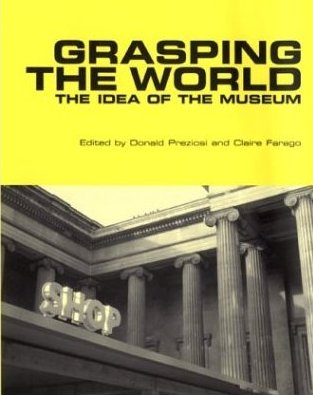Dancing with the one that brung ya and challenging the dominant narrative
Last week, I was at the Hirshorn Museum, and a book in the gift shop, Grasping the World: The Idea of the Museum, caught my attention. Since being introduced to the idea of the cultural landscape as an organizing methodology for explaining and interpreting places (the "cultural landscape" is how one organizes the development and presentation of "heritage areas") I have become a lot more willing to think about places and ideas and concepts in terms of cultural studies, something I had been a bit derisive of in the past.
(I happened to attend two trainings at the National Trust for Historic Preservation conference in 2004, one on "Great Tours" which is about historic house and small museums and how to rethink presentation and narrative and the other by the Alliance of National Heritage Areas. Both were excellent. I have written about this in the past... and this entry from a year ago about Brookland covers similar kinds of issues, "Thinking about local history (revised).")

To get a taste of some of the literature on the latest thinking in museums check out this set of reviews from this 2007 back issue of reCollections, the Journal of the National Museum of Australia. As well as this paper, also from that journal, "Meeting the challenges of the future: Museums and the public good."
The book is about the changing role of the museum with a European focus, and this review of the book isn't too laudatory, saying:
Instead, [it's] aimed at the increasingly large army of students and cultural critics who wander round museums regarding them as vaguely distasteful manifestations of elite culture and deplore the ostensibly innocent pleasure that they bring to their many millions of visitors. Of the two, my vote goes to the one edited by Donald Preziosi and Claire Farago. This has the great virtue of being clearly and systematically structured and of being part of a larger historical enterprise on the part of both authors to think carefully about the nature of museums as historical and cultural phenomena.
Today's Post includes a critical column by Marc Fisher about the reopened National Museum of American History not being very challenging about interpreting American history. See "Museum's Star-Spangled Makeover Neglects Nitty-Gritty of U.S. History."
I don't disagree with him, but I think it reflects an overly facile understanding of the tightrope that the various units of the Smithsonian Institution walk between being "national" museums financially supported by the Federal Government (in particular Congress) and places of education, scholarship, collection, research, interpretation, and challenge. Those of us interested in social psychology call this a problem of "boundary spanning," having to reconcile often oppositional forces.
The U.S. isn't a country that values criticism or being challenged*. (* Neither do blog writers or journalists.) It doesn't even value intelligence and education very much, if the kind of campaign mounted by presidential hopeful John McCain and especially Sarah Palin, is an indicator. (Also see the very old book--28 years--by Frances FitzGerald America Revised about the telling of American history.)
Right now the Smithsonian faces a great deal of criticism for its financial management and direction (it would take a full blown essay to cover that). The Post has covered that quite a bit, including this recent article, "The Smithsonian Fields The People's Questions" and editorial, "Openings at the Smithsonian: Public meetings -- and a remodeled museum -- are welcome." And Congress has been at the forefront of that. So the Smithsonian Institution and its units are even more scared than usual about challenging the status quo of historiography and interpretation.
Even so, Federal funding of arts and culture has always been difficult when it comes to challenging discourse and "pushing the envelope." I am hardly an expert at the ins and outs of the National Endowment of the Arts and the National Endowment of the Humanities, but I still remember the public outcry over photos by Robert Mapplethorpe being exhibited at the Corcoran Gallery of Art in the 1990s. Or Lynne Cheney, who was the chair of the NEH during the Reagan-Bush years and who criticized a college instructor for teaching a course with content that challenged the traditional ways of presenting America as an always great country. But all you need is one Congressman to make it an issue, and then things get even worse. (Remember that many federal and municipal employees work from the perspective of "I don't want to do anything that can end up written about in the A or Metro sections of the Post" thinking that such coverage is usually negative.)

Saluting the flag during the Pledge of Allegiance. Original source unknown.
But the Smithsonian has yet another problem. It's a federal agency and it gets focused as a result on bureaucratization and stasis rather than change and intellectual excitement and fervor.(Ironically, "tenure" in academia is supposed to support professors in continuing to take on challenging issues, but at the same time reduction of movement in staff limits an organization's ability to continue to extend itself intellectually.) Granted, you need some distance as trendy trends don't always have staying power, but...
This is interesting because there are other articles out now about some of these same kinds of issues, but in terms of politics, such as "Republicans Seek to Fix Short-Sitedness " from today's Post about a youngster-led challenge to help the Republican party reposition and rethink and other discussions about tribulations faced by the National Review as an intellectual-based organ of conservative thinking.
When you're in power, you aren't likely favorable to being challenged intellectually or programmatically. When you are out of power you can be more willing to listen and rethink (I call this, in the context of urban revitalization, "a desperate willingness to experiment" in communities that have no other choices when I compare cities like Pittsburgh and Baltimore to DC in terms of arts and culture as a revitalization strategy) But you still don't like it.

CHRIS A. COUROGEN, The Patriot-News. The line for this afternoon's John McCain-Sarah Palin rally at Franklin & Marshall College's Alumni Sports and Fitness Center Field House stretches around the building. See "Thousands greet McCain, Palin in Lancaster" from the Harrisburg Patriot-News.
But in any case, those "Real Americans" as outlined by Sarah Palin or the "Real Virginians" that George Allen laments aren't up for hearing about or looking at an exhibit at a museum about how the U.S. Constitution sanctioned slavery, how the post-Civil War South was virulently racist and the Federal Government let it slide, about the CIA operating in and overthrowing nations such as Iran or in Central America or Chile and how it has impacted how other countries and peoples consider the role of the U.S. in the world, even Cuba.
Especially at one of the "National" Museums of the United States, at the Smithsonian.
Imagine if the National Museum of American History used "Empire as a Way of Life" (the title of a book by William Appleman Williams) as the interpretive framework for exhibits on U.S. foreign policy and the creation of a continental United States. Can you say "fire the curator"?
Remember the hullaballoo about a slightly critical interpretive label for the Enola Gay at the National Air and Space Museum?
Or even the critical reviews of the National Museum of the American Indian when it first opened, because people had a hard time grappling with a Native American-centric interpretation framework. I too was critical before I went to the Museum for the first time, but seeing the displays and exhibits, I understood--from a cultural studies standpoint--what they are trying to do.
DC is a tough city to do criticism in. If you want critical discourse in museums and exhibits, for the most part, you have to go elsewhere.
Another place that has a hard time with modernizing cultural interpretational frameworks is the South. For example the issue of the Confederate flag as a "cultural artifact." The Museum of the Confederacy in Richmond is failing, for obvious reasons. It was founded with a framework of reverence about the Confederate cause. Now it's 140 years later and times have (and continue to) changed. So does or so should how cultural institutions interpret history and present exhibits.
Similarly, earlier in the year we went for a weekend to Petersburg, Virginia, which has probably never really recovered from its siege by Union forces in 1864 and 1865. The city has a Department of Museums which manages a number of landmarks (for the most part they are underfunded) but I was really struck by the lack of modernization of the interpretational framework at least in terms of how the docents presented (not necessarily the set of new interpretational signs downtown). In short, not too much criticism of the Confederates, and a failure to interpret the Civil War in terms of the creation of a national industrially based economy, Eli Whitney's cotton gin notwithstanding.

A section of the Petersburg's Old Towne panel adjacent to the Tourism-History Narrative Kiosk, Downtown Petersburg, VA.
I just can't imagine a conference in DC on boundary spanning, cultural studies, and modernizing our historical interpretative frameworks anytime soon.
But a good example of how this has been done is in the updating of the interpretation of the Founding of Jamestown in terms of reinterpreting the narrative by telling the story of three different peoples separately and simultaneously: the English colonists; the Native Americans; and African-Americans brought to Virginia as slaves. This is done at the Jamestown Museum, which is run by the State of Virginia (and isn't located at the Jamestown Settlement site, which is run by the National Park Service. The same framework was employed by the Smithsonian Folklife Festival in 2007, by having Kent, England, Native American, and Ghanian cultures presented at the Festival. (Similarly, the region has updated its narrative as well--Jamestown as the founding of the United States, Williamsburg as the place for developing a state and nation, and Yorktown as the location of the decisive battle of the Revolutionary War, leading to the founding of the United States as a nation separate from England.)
But while I think there needs to be a true "Vision Plan" for the Smithsonian Institution, not merely an updated "strategic plan" I don't see this happening. The various museums are pretty hidebound (Marc Fisher's point in a nutshell) and resistant to change.
They already believe that they are world class institutions--maybe they are maybe they aren't--but they aren't too interested in having to reflect and challenge themselves internally, judging by the negative reaction of the Smithsonian art museums to external review a couple years ago(reported in great depth within the Post), which led, ultimately, to the dissolution of the Office of the Undersecretary of Art, overseeing and coordinating the Smithsonian art museums, and the merging of that responsibility into the Undersecretary overseeing the history mueums.
Labels: arts-based revitalization, arts-culture, cultural heritage/tourism, cultural planning, museums



1 Comments:
A book coming out in 2021, _The Myth of Museums: Why Cultural Institutions Can't Be Neutral in an Age of Protest_ by Laura Raicovich.
Post a Comment
<< Home